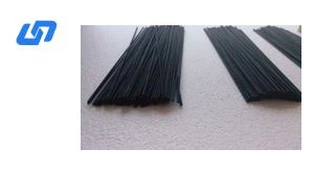What is the electrolysis of sodium chloride?
Electrolysis of sodium chloride:
The salt solution contains several ions such as Na+, H-, etc. According to the electrolysis theory, when the electrode is inserted, under a certain voltage, the electrolyte solution conducts electricity due to the movement of ions and the electrode reaction. At this time, Cl-, OH- Negative ions move to the anode, while positive ions such as Na+ and H+ move to the cathode, and discharge occurs on the corresponding electrodes, so as to carry out redox reactions and produce corresponding substances.
Cathodic reaction:2Cl--2e=Cl2↑
Anode reaction:2H++2e=H2↑
Sodium chloride (NaCl) and water (H2O) in the solution are ionized. After electrification, hydrogen gas (H2) and chlorine gas (Cl2) are generated at the cathode and anode respectively. The remaining hydroxide ions and sodium ions combine to form sodium hydroxide (NaOH). Electrolysis of sodium chloride solution reaction equation:
2NaCl+2H2O=2NaOH+2H2↑+2Cl2↑.
Electrolysis of sodium chloride without memebrane:
When electrolysis without membrane is used in industry, sodium chloride and sodium hypochlorite will be generated due to the contact of chlorine ions or chlorine gas with sodium hydroxide. In electrolysis of brine without membrane, the total equation of the solution is NaCl+H2O+2F→NaClO+H2↑ Where: F is Faraday's electrolytic constant, its value is 26.8A/h or 96487 coulombs.
The process without membrane is mainly used in the production of sodium hypochlorite generator for electrolysis of dilute brine. The sodium hypochlorite generator is composed of electrolytic tank, silicon rectifier electric control cabinet, salt dissolving tank, cooling system and supporting UPVC pipes, valves, water injectors, flow meters, etc. Add 3~4 dilute salt solution into the electrolytic cell, turn on the 12V DC power supply, and electrolyze to produce sodium hypochlorite by adjusting the electrolytic current, absorb and mix the disinfectant solution by the water injector, or use the metering pump to measure and send the disinfectant solution through the mixer. The main component of the electrolytic cell is the titanium anode assembly. Generally, the anode and cathode are coated, and the electrode inversion process is adopted. It is widely used in hospital water disinfection, swimming pool water disinfection, hotel disinfection, color and odor removal, bleaching and other fields.
Changsheng Company is currently able to produce titanium electrode with 50g/h to 5kg/h chlorine gas, which can be customized and processed according to customers' drawings. Welcome to consult!
Electrolysis of sodium chloride with membrane:
The sodium hydroxide(NaOH) produced by the chlor-alkali industry uses a specially constructed electrolytic cell with an ion-exchange membrane (which does not allow negatively charged chloride ions or chlorine gas to pass through) to isolate chloride ions or chlorine gas from sodium hydroxide(NaOH).The ion-membrane method electrolyzer can produce high-purity lye with about 35% sodium hydroxide, which can be used directly as a commodity, and can also be concentrated into 50% liquid caustic soda by evaporator.
The chlorine(Cl2) gas escaping from the chamber of electrolytic cells is directly cooled by water spray or indirectly cooled in a titanium cooler, and then dried with concentrated sulfuric acid in a series-connected drying tower to obtain the raw material chlorine gas; then further compressed and liquefied Cooled into liquid chlorine.
Hydrogen(H2) is used as fuel after cooling and dehydration, or is dried and compressed and stored in steel cylinders (or through pipelines) as industrial raw materials








